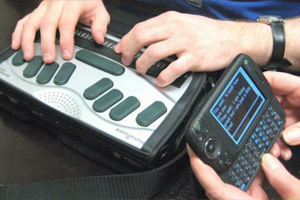Since my friend at college has some night blindness, I particularly wanted to know about the rules on accessibility. Is there a law covering computers?
We appreciate a question that is for someone other than yourself. While your laptop is easy for you to use, a visually impaired or blind person will need another keyboard that can easily be purchased. However, who is responsible for assuring websites are compliant with the ADA (American with Disabilities Act)? This has recently become a hot legal issue, even though the Internet was created a generation ago. The courts were slow to catch up with the new technology.
More than 3% of the US population over 40 is visually impaired or blind. You are enjoying college, but less than 15% with impaired eyesight receive a bachelor’s degree.
Title III of the ADA focuses on barriers to those with disabilities, such as wheelchair access, acceptance of guide dogs, and accommodations for those with hearing or vision disabilities. Many firms think you can simply buy products that offer accessibility, explains a manufacturer of commercial door handles. While the products meet compliance standards, it’s in the installation where companies must understand the needs of those with disabilities.
In 2010, the Department of Justice, responsible for enforcing the ADA, extended the act to websites. Enforcement actions are now ongoing and increasing. In 2015, the DOJ received 6,391 accessibility complaints, 40% higher than the previous year.
Law firms are all over this, circulating letters to companies, institutions and universities on behalf of disabled individuals. These letters identify alleged ADA violations and request that companies update their websites to become World Wide Web Consortium (W3C) and ADA compliant.
Businesses in New York and California are bearing the brunt of the complaints. Big-name retailers such as Shake Shack, Nordstrom, Mac Cosmetics, Warby Parker, and Florida’s Winn-Dixie Stores have all been named in law suits claiming that their websites do not provide the required ‘public accommodations’ for the disabled. A recent ruling in Florida required websites must be compatible with screen-reading software or technologies for the visually impaired.
It was estimated the cost would be $37,000 to make a website ADA compliant; a big bill to swallow for a small business. A lot of suits are targeting restaurants, since the visually impaired are frequent patrons. If menus and websites are inaccessible, lawsuits are likely to follow. While federal law prohibits awarding damages from ADA suits, lawyers can claim their fees which of course can run into tens-of-thousands.
There are a number of steps that online businesses can take to make their websites compliant. These include using an ADA agency that is familiar with the software that powers the site. Online tools can scour the website to audit the code for areas that do not meet accessibility standards. The physical changes would include ‘alt text’ to describe images that may not display proper and correctly functioning web forms.
“Our company has been assuring ADA compliance for brick-and-mortar establishments for a generation”, says ADA Central Signs. “The websites should quickly embrace these new changes to increase overall functionality, potential customers, and general search visibility”.
Just because a man lacks the use of his eyes doesn’t mean he lacks vision – Stevie Wonder.
(Jacob Maslow is the founder and editor of Legal Scoops).


